Fluctuation of Plasmonically Induced Transparency Peaks within Multi-Rectangle Resonators
Abstract
:1. Introduction
2. Model and Theoretical Analysis
3. Results and Discussions
4. Conclusions
Author Contributions
Funding
Informed Consent Statement
Acknowledgments
Conflicts of Interest
References
- Kazanskiy, N.L.; Khonina, S.N.; Butt, M.A. Plasmonic sensors based on Metal-insulator-metal waveguides for refractive index sensing applications: A brief review. Physica E 2020, 117, 113798. [Google Scholar] [CrossRef]
- Barnes, W.L.; Dereux, A.; Ebbesen, T.W. Surface plasmon subwavelength optics. Nature 2003, 424, 824–830. [Google Scholar] [CrossRef] [PubMed]
- Genet, C.; Ebbesen, T.W. Light in tiny holes. Nature 2007, 445, 39–46. [Google Scholar] [CrossRef]
- Neutens, P.; Dorpe, P.V.; Vlaminck, I.D.; Lagae, L.; Borghs, G. Electrical detection of confined gap plasmons in metal-insulator-metal waveguides. Nat. Photon. 2009, 3, 283–286. [Google Scholar] [CrossRef]
- Huang, B.; Meng, H.Y.; Wang, Q.H.; Wang, H.H.; Zhang, X.; Yu, W.; Tan, C.H.; Huang, X.G.; Wang, F.Q. Plasmonic-Induced Transparency and Slow-Light Effect Based on Stub Waveguide with Nanodisk Resonator. Plasmonics 2016, 11, 543–550. [Google Scholar] [CrossRef]
- Haus, H.; Huang, W.P. Couple-mode theory. Proc. IEEE 1991, 79, 1505–1518. [Google Scholar] [CrossRef] [Green Version]
- Wang, J.C.; Niu, Y.Y.; Liu, D.D.; Hu, Z.D.; Sang, T.; Gao, S.M. Tunable plasmon-induced transparency effect in MIM side-coupled isosceles trapezoid cavities system. Plasmonics 2018, 13, 609–616. [Google Scholar] [CrossRef]
- Song, C.; Qu, S.N.; Wang, J.C.; Tang, B.J.; Xia, X.S.; Liang, X.Y.; Lu, Y.N. Plasmonic tunable filter based on trapezoid resonator waveguide. J. Mod. Opt. 2015, 62, 1400–1404. [Google Scholar] [CrossRef]
- Wang, J.C.; Sun, L.; Hu, Z.D.; Liang, X.Y.; Liu, C. Plasmonic-induced transparency of unsymmetrical grooves shaped metal–insulator–metal waveguide. AIP Adv. 2014, 4, 123006. [Google Scholar] [CrossRef]
- Steglich, P.; Bondarenko, S.; Mai, C.; Paul, M.; Michael, G.; Weller, M.A. CMOS-compatible silicon photonic sensor for refractive index sensing using local back-side release. IEEE Photonics Technol. Lett. 2020, 32, 1241–1244. [Google Scholar] [CrossRef]
- Zhao, L.; Liu, S.; Wang, J.; Shen, X.P.; Cui, T.J. Band-stop filter based on spoof surface plasmon polaritons. Electron. Lett. 2019, 55, 607–609. [Google Scholar] [CrossRef]
- Wang, B.J.; Zhu, S.S.; Guo, B. Surface plasmon polaritons in plasma-dielectric-magnetic plasma structure. Plasma Sci. Technol. 2020, 11, 45–51. [Google Scholar] [CrossRef]
- Li, L.; Dong, L.; Chen, P.; Yang, K. A low insertion loss low-pass filter based on single comb-shaped spoof surface plasmon polaritons. Int. J. Microw. Wirel. Technol. 2019, 11, 792–796. [Google Scholar] [CrossRef]
- Ding, Z.Q.; Dai, D.X.; Shi, Y.C. Ultra-sensitive silicon temperature sensor based on cascaded Mach-Zehnder interferometers. Opt. Lett. 2021, 46, 2787–2790. [Google Scholar] [CrossRef] [PubMed]
- Zhou, S.H.; Shen, Z.X.; Kang, R.Y.; Ge, S.J.; Hu, W. Liquid crystal tunable dielectric metamaterial absorber in the terahertz range. Appl. Sci. 2018, 8, 2211. [Google Scholar] [CrossRef] [Green Version]
- Liu, H.Q.; Gao, Y.X.; Zhu, B.F.; Ren, G.B.; Jian, S.S. A T-shaped high resolution plasmonic demultiplexer based on perturbations of two nanoresonators. Opt. Commun. 2015, 334, 164–169. [Google Scholar] [CrossRef]
- Butt, M.A.; Khonina, S.N.; Kazanskiy, N.L. A plasmonic colour filter and refractive index sensor applications based on metal-insulator-metal square micro-ring cavities. Laser Phys. 2020, 30, 016205. [Google Scholar] [CrossRef]
- Liu, S.L.; Ma, X.Y.; Song, M.; Ji, C.Y.; Song, J.; Ji, Y.L.; Ma, S.J.; Jiang, J.; Wu, X.C.; Li, J.F.; et al. Plasmonic Nanosensors with Extraordinary Sensitivity to Molecularly Enantioselective Recognition at Nanoscale Interfaces. ACS Nano 2021, 15, 19535–19545. [Google Scholar] [CrossRef]
- Ostovan, A.; Naghavi, S.S. Highly efficient metalloporphyrin-based nanosensors for NO detection. Phys. Chem. Chem. Phys. 2022, 24, 15579–15587. [Google Scholar] [CrossRef]
- Ramani, U.; Kumar, H.; Singh, B.K.; Pandey, P.C. Design of surface plasmon resonance based both side polished photonic crystal fiber for highly efficient refractive index sensor. Optik 2021, 248, 168062. [Google Scholar] [CrossRef]
- Wang, S.; Yu, S.; Zhao, T.; Wang, Y.; Shi, X. A nanosensor with ultra-high FOM based on tunable malleable multiple Fano resonances in a waveguide coupled isosceles triangular resonator. Optic. Commun. 2020; 465, 125614. [Google Scholar]
- Zhu, L.; Li, H.D.; Dong, L.; Zhou, W.J.; Rong, M.X.; Zhang, X.Z.; Guo, J. Dual-band electromagnetically induced transparency (EIT) terahertz metamaterial sensor. Opt. Mater. Express 2021, 11, 2109–2121. [Google Scholar] [CrossRef]
- Zhu, S.S.; Wen., P.; Liu, Y.H. Multi-band propagation of spoof surface plasmon polaritons by its high-order modes. Jpn. J. Appl. Phys. 2022, 61, 070907. [Google Scholar] [CrossRef]
- Su, W.; Ding., Y.M.; Luo, Y.L.; Liu, Y. A high figure of merit refractive index sensor based on Fano resonance in all-dielectric metasurface. Results Phys. 2020, 16, 102833. [Google Scholar] [CrossRef]
- Chen, J.F.; Li, J.N.; Liu, X.; Rohimah, S.; Tian, H.; Qi, D.W. Fano resonance in a MIM waveguide with double symmetric rectangular stubs and its sensing characteristics. Opt. Commun. 2021, 482, 126563. [Google Scholar] [CrossRef]
- Zhang, Z.J.; Yang, J.B.; He, X.; Zhang, J.J.; Huang, J.; Chen, D.B.; Han, Y.X. Plasmonic refractive index sensor with high figure of merit based on concentric-rings resonator. Sensors 2018, 18, 116. [Google Scholar] [CrossRef] [Green Version]
- Ouyang, X.; Xu, Y.; Feng, Z.W.; Tang, W.Y.; Cao, Y.Y.; Li, X.P. Polychromatic and polarized multilevel optical data storage. Nanoscale 2019, 11, 2447–2452. [Google Scholar] [CrossRef]
- Hsu, H.; Cheng, C.Y.; Shiu, J.S.; Chen, L.C.; Chen, Y.F. Quantum fidelity of electromagnetically induced transparency: The full quantum theory. Opt. Express 2022, 30, 2097–2111. [Google Scholar] [CrossRef]
- Guo, Y.Y.; Huo, Y.P.; Niu, Q.Q.; He, Q.; Hao, X.X. Band-stop filter based on tunable Fano resonance and electromagnetically induced transparency in metal-dielectric-metal waveguide coupling systems. Phys. Scr. 2020, 96, 015507. [Google Scholar] [CrossRef]
- Liu, D.D.; Sun, Y.; Fan, Q.B.; Mei, M.F.; Wang, J.C.; Pan, Y.W.; Lu, J. Tunable Plasmonically Induced Transparency with Asymmetric Multi-rectangle Resonators. Plasmonics 2016, 11, 1621–1628. [Google Scholar] [CrossRef]
- Ge, J.H.; You, C.L.; Feng, H.; Li, X.M.; Wang, M.; Dong, L.F.; Veronis, G.; Yun, M.J. Tunable dual plasmon-induced transparency based on a monolayer graphene metamaterial and its terahertz sensing performance. Opt. Express 2020, 28, 31781–31795. [Google Scholar] [CrossRef]
- Naghizadeh, S.; Kocabas, S.E. Guidelines for designing 2D and 3D plasmonic stub resonators. J. Opt. Soc. Am. B 2017, 34, 207–217. [Google Scholar] [CrossRef] [Green Version]
- Noual, A.; Abouti, O.E.; El Boudouti, E.H.; Akjouj, A.; Pennec, Y.; Djafari-Rouhani, B. Plasmonic-induced transparency in a MIM waveguide with two side-coupled cavities. Appl. Phys. A 2017, 123, 1–7. [Google Scholar] [CrossRef]
- Yun, B.F.; Hu, G.H.; Cong, J.W.; Cui, Y.P. Plasmon induced transparency in metal–insulator–metal waveguide by a stub coupled with FP resonator. Mater. Res. Express 2014, 1, 036201. [Google Scholar] [CrossRef]
- Mashayekhi, M.Z.; Abbasian, K.; Nurmohammadi, T. Dual-wavelength active and tunable modulation at telecommunication wavelengths using graphene-metal hybrid metamaterial based on plasmon induced transparency. Phys. Scr. 2022, 12, 095503. [Google Scholar] [CrossRef]
- Yang, X.D.; Liu, Y.M.; Oulton, R.F.; Yin, X.B.; Zhang, X.Z. Optical forces in hybrid plasmonic waveguides. Nano Lett. 2011, 11, 321–328. [Google Scholar] [CrossRef]
- Mohammad, A.Z.; Lambertus, H.L. Dynamically controllable plasmonic tweezers using C-shaped nano-engravings. Appl. Phys. Lett. 2022, 121, 181108. [Google Scholar]
- Chen, Y.; Ming, H. Review of surface plasmon resonance and localized surface plasmon resonance sensor. Photonic Sens. 2012, 2, 37–49. [Google Scholar] [CrossRef] [Green Version]
- Lin, X.S.; Huang, X.G. Tooth-shaped plasmonic waveguide filters with nanometeric sizes. Opt. Lett. 2008, 33, 2874. [Google Scholar] [CrossRef] [Green Version]
- Blessan, T.M.; Venkateswaran, C.; Yogesh, N. All-optical terahertz logic gates based on coupled surface plasmon polariton sub-wavelength waveguiding in bulk Dirac semimetal. Optik 2022, 257, 168795. [Google Scholar] [CrossRef]
- Shen, Z.Y.; Xiang, T.Y.; Wu, N.; Wu, J.; Tian, Y.; Yang, H.L. Dual-band electromagnetically induced transparency based on electric dipole-quadrupole coupling in metamaterials. J. Phys. D 2019, 52, 1. [Google Scholar] [CrossRef]
- Zou, S.W.; Wang, F.Q.; Liang, R.S.; Xiao, L.P.; Hu, M. A nanoscale refractive index sensor based on asymmetric plasmonic waveguide with a ring resonator: A review. IEEE Sens. J. 2015, 15, 646–650. [Google Scholar] [CrossRef]
- Wang, T.C. Generalized temporal coupled-mode theory for a P T-symmetric optical resonator and Fano resonance in a P T-symmetric photonic heterostructure. Opt. Express 2022, 30, 37980–37992. [Google Scholar] [CrossRef] [PubMed]
- Qu, S.N.; Song, C.; Xia, X.S.; Liang, X.Y.; Tang, B.J.; Hu, Z.D.; Wang, J.C. Detuned plasmonic Bragg grating sensor based on defect metal-insulator-metal waveguide. Sensors 2016, 16, 784. [Google Scholar] [CrossRef] [PubMed] [Green Version]
- Mendez, A.M.; Okayama, H.; Nakajima, H. Silicon optical filter with transmission peaks in wide stopband obtained by anti-symmetric photonic crystal with defect in multimode waveguides. Opt. Express 2018, 26, 1841–1850. [Google Scholar] [CrossRef]
- Wang, W.; Zhou, Y.C.; Wang, F.; Tan, J.W.; Teng, H.B.; Wang, H.D. Two-dimensional equivalent Model design of surface acoustic wave devices based on COMSOL. Piezoelectr. Acoustooptics 2021, 43, 605–608. [Google Scholar]
- Han, Z.H.; Bozhevlnyi, S.I. Plasmon-induced transparency with detuned ultracompact Fabry-Perot resonators in integrated plasmonic devices. Opt. Express 2011, 19, 3251–3257. [Google Scholar] [CrossRef]
- Tang, B.J.; Wang, J.C.; Xia, X.S.; Liang, X.Y.; Song, C.; Qu, S.N. Plasmonic induced transparency and unidirectional control based on the waveguide structure with quadrant ring resonators. Appl. Phys. Express 2015, 8, 032202. [Google Scholar] [CrossRef]
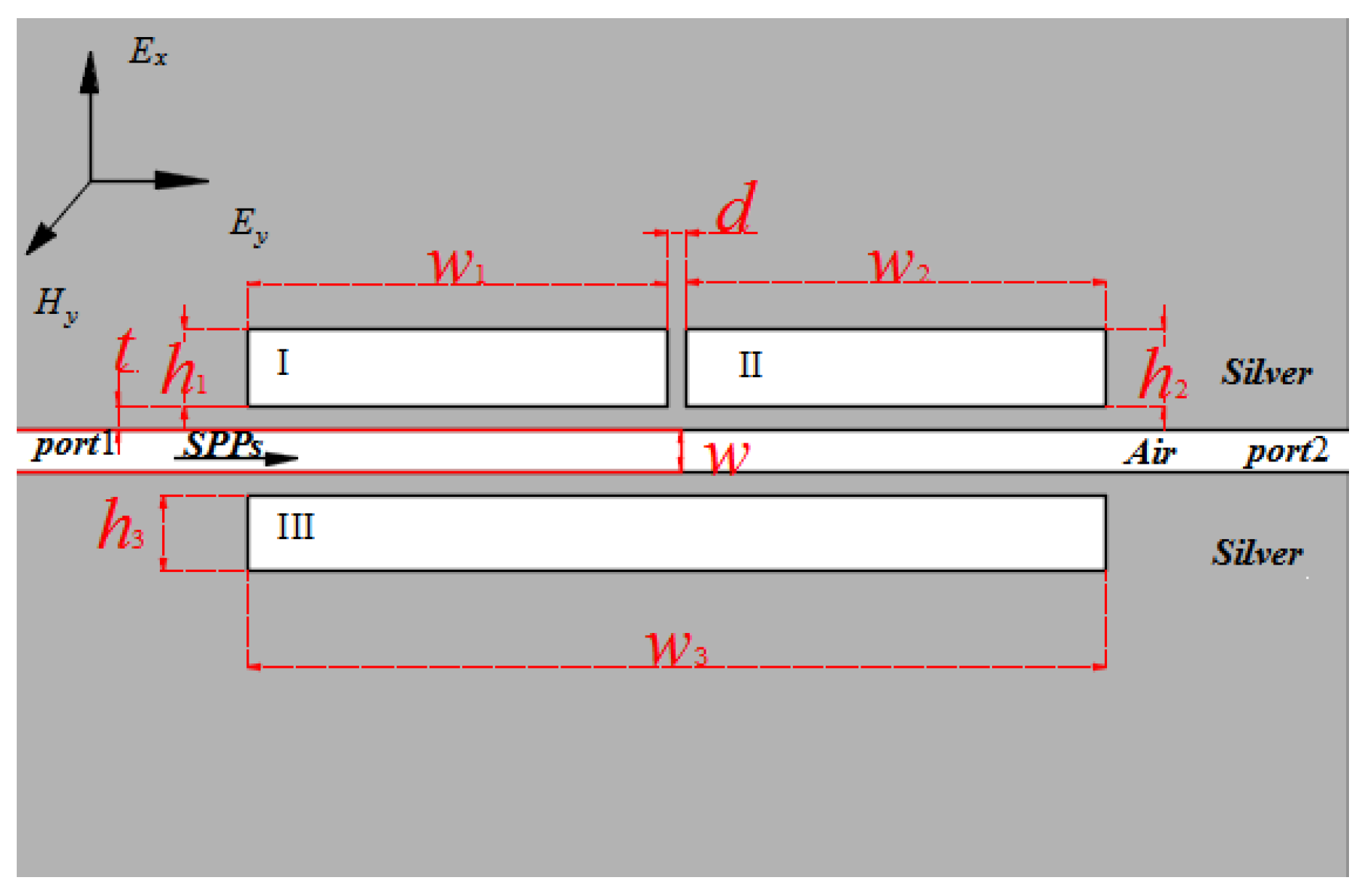
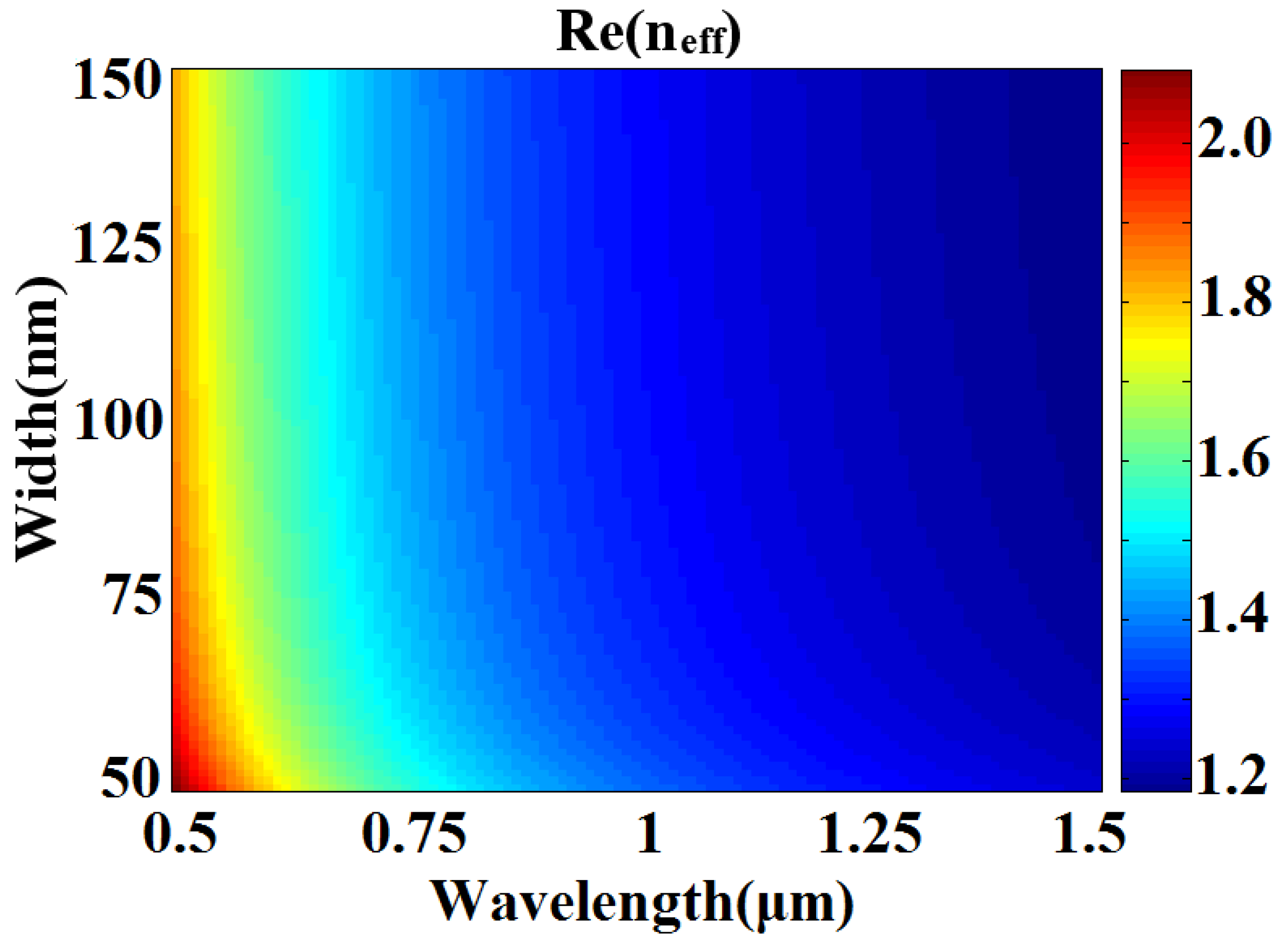



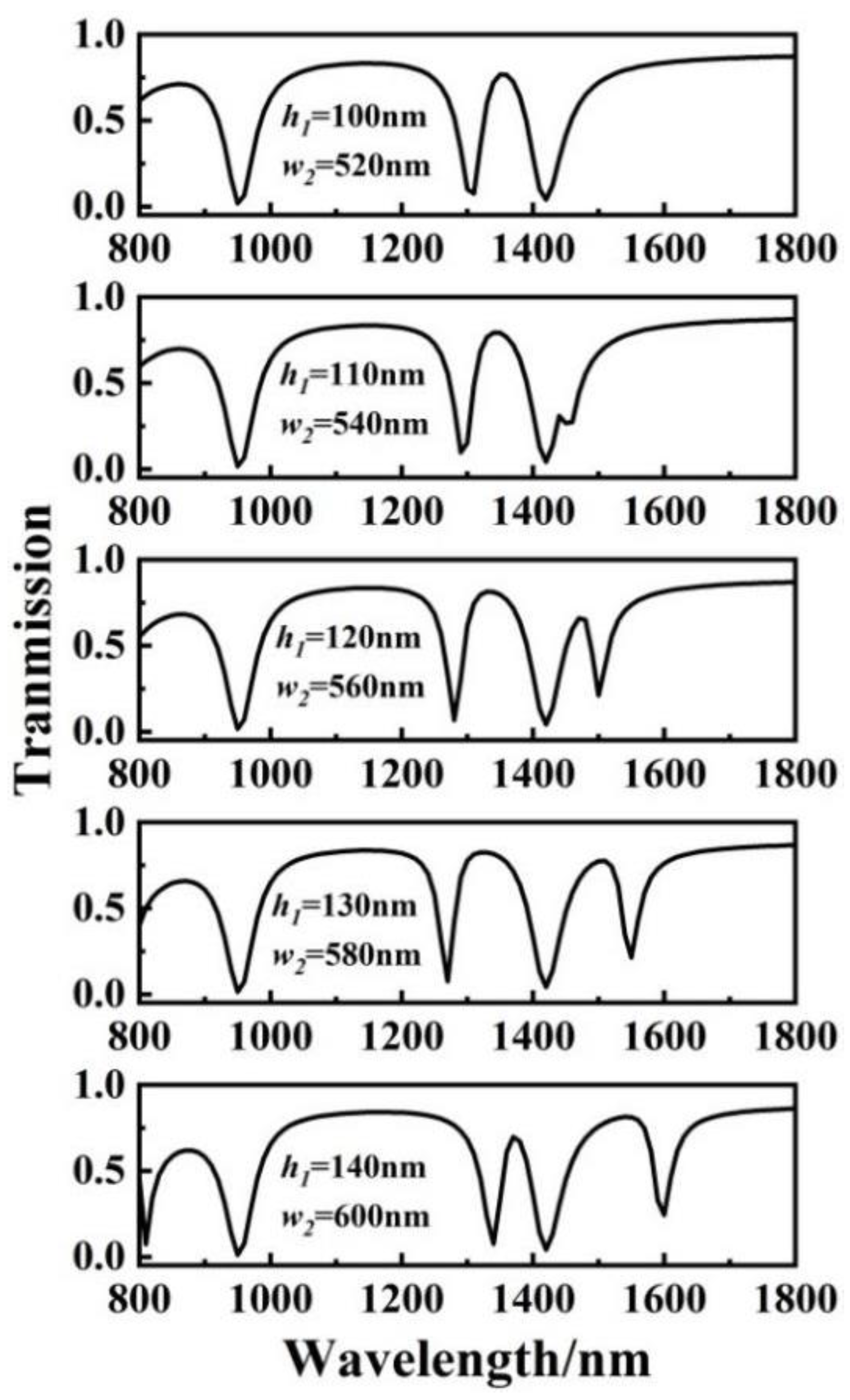
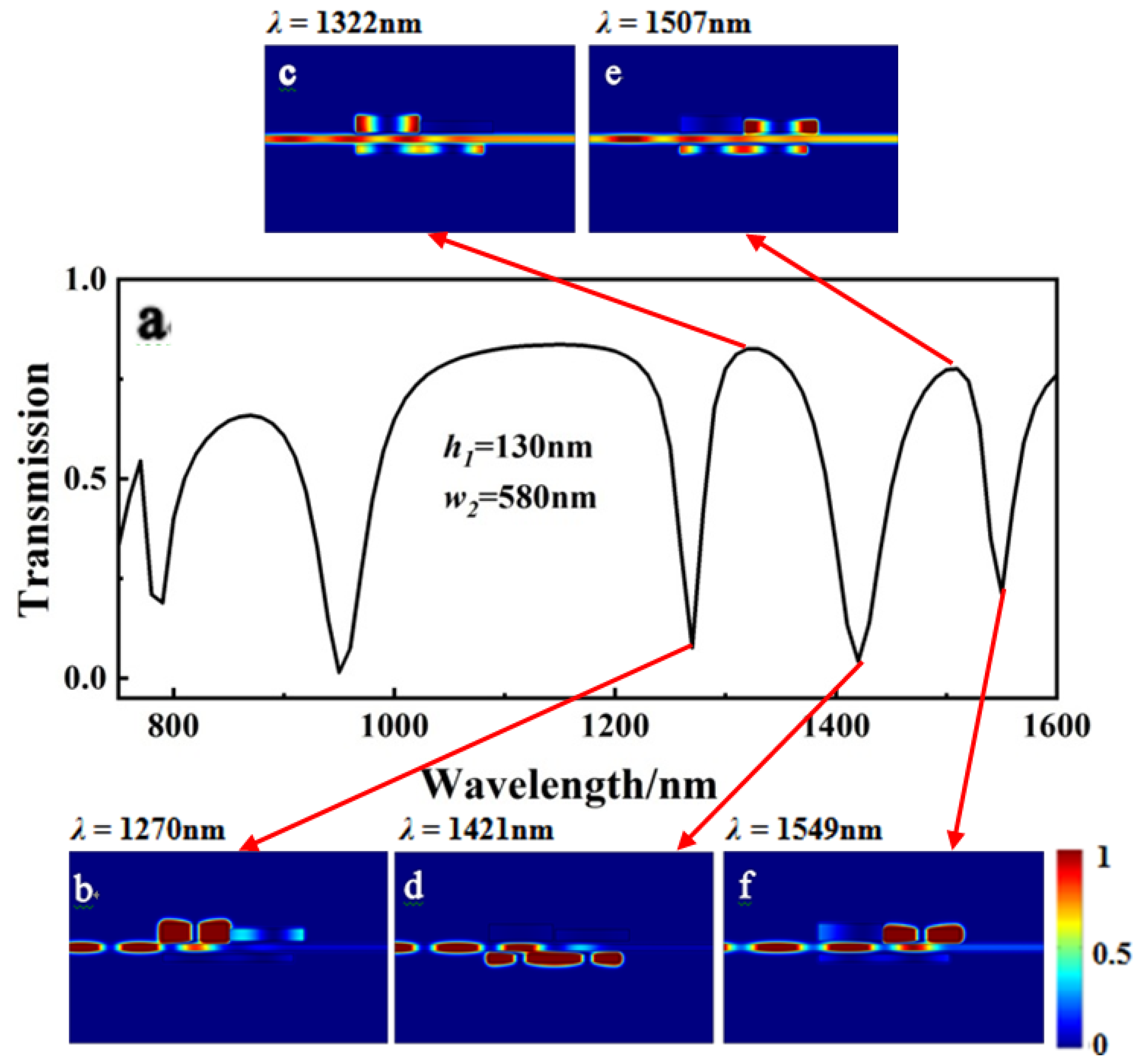
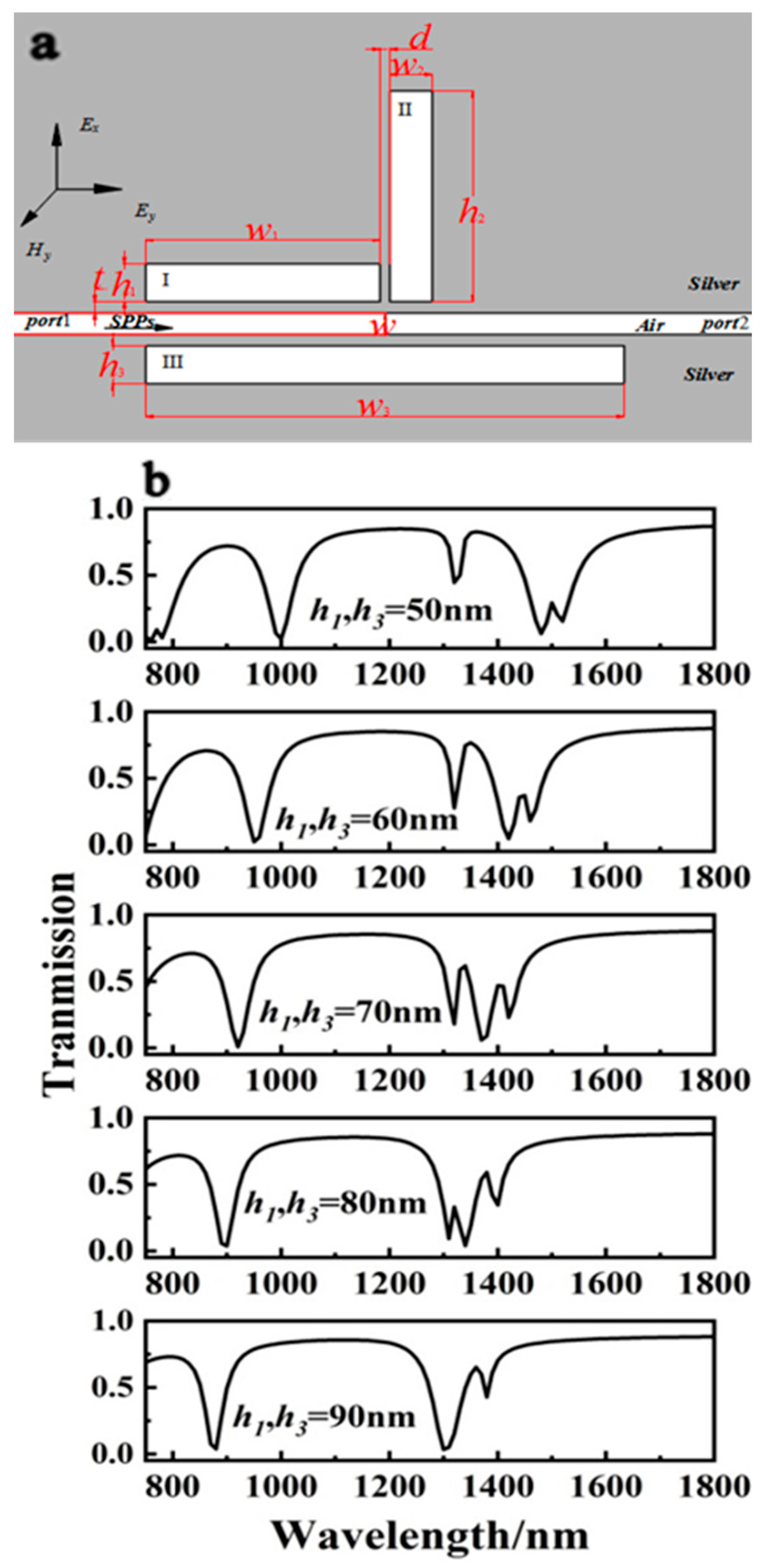


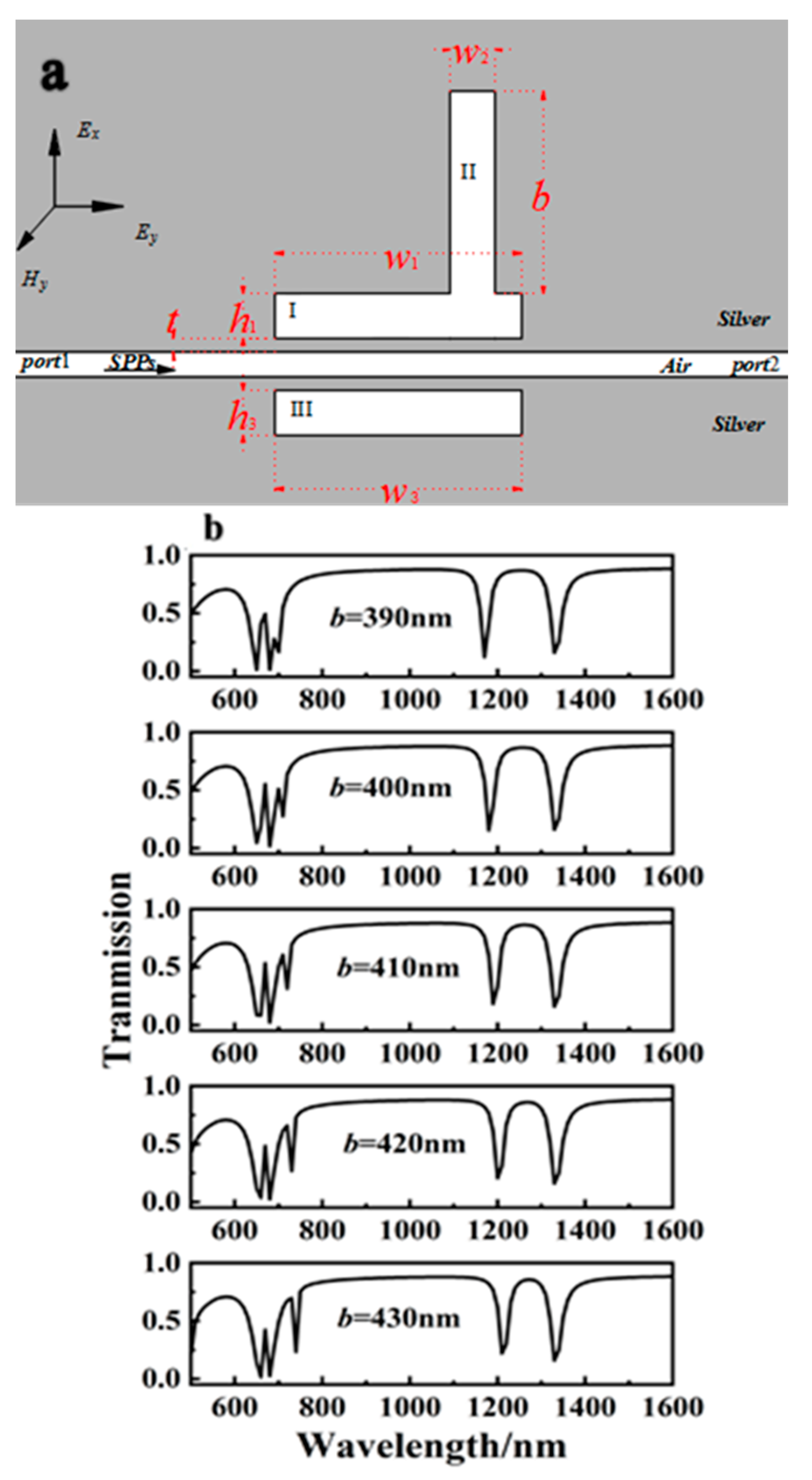

Disclaimer/Publisher’s Note: The statements, opinions and data contained in all publications are solely those of the individual author(s) and contributor(s) and not of MDPI and/or the editor(s). MDPI and/or the editor(s) disclaim responsibility for any injury to people or property resulting from any ideas, methods, instructions or products referred to in the content. |
© 2022 by the authors. Licensee MDPI, Basel, Switzerland. This article is an open access article distributed under the terms and conditions of the Creative Commons Attribution (CC BY) license (https://creativecommons.org/licenses/by/4.0/).
Share and Cite
Pei, R.; Liu, D.; Zhang, Q.; Shi, Z.; Sun, Y.; Liu, X.; Wang, J. Fluctuation of Plasmonically Induced Transparency Peaks within Multi-Rectangle Resonators. Sensors 2023, 23, 226. https://doi.org/10.3390/s23010226
Pei R, Liu D, Zhang Q, Shi Z, Sun Y, Liu X, Wang J. Fluctuation of Plasmonically Induced Transparency Peaks within Multi-Rectangle Resonators. Sensors. 2023; 23(1):226. https://doi.org/10.3390/s23010226
Chicago/Turabian StylePei, Ruoyu, Dongdong Liu, Qun Zhang, Zhe Shi, Yan Sun, Xi Liu, and Jicheng Wang. 2023. "Fluctuation of Plasmonically Induced Transparency Peaks within Multi-Rectangle Resonators" Sensors 23, no. 1: 226. https://doi.org/10.3390/s23010226




